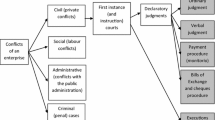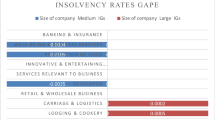Abstract
We analyze the economic consequences on firm profitability, performance, and investments of having another firm in the same market affiliated with a criminal organization. We do so by evaluating the spillover effects of a law providing the judicial administration of organized crime firms through the imposition of external managers in order to remove the connection to the criminal organization, and at the same time guarantee the continuity of production. By using detailed information on more than 180,000 companies, we exploit the firms’ yearly variation in the exposure to criminal firms’ judicial administration in their market (in the same province and industry). The empirical design allows us to control for confounding effects at the firm, market, and year levels. The results show that there is a large, positive spillover from the enforcement law, suggesting that the burden the organized crime firms impose on other firms is very large. Firms’ performance and turnover increases by 2.2 and 0.7%, respectively, in the first 4 years after an organized crime firm enters the status of judicial administration. Investments measured by tangible and intangible assets increase with the number of firms entering into judicial administration by 0.75%. These results suggest that intensifying confiscation measures against criminal organizations has a strong positive effect on the economy.






Similar content being viewed by others
Notes
In a recent paper, Mirenda et al. (2019) study the mechanisms through which criminal organizations (in particular the ‘ndrangheta’) infiltrates into the legal economy and the consequences of infiltration on firms captured by the criminal organization in the Center and North of Italy. Organized crime typically targets firms in financial distress and potentially subject to shocks from the public sector demand. Mirenda et al. (2019) find that the firms captured by organized crime strongly increase their revenues.
Obviously, the loss that a criminal firm experiences through JA is more than offset by the increase in the performance of legal firms.
Confiscation takes place after a final judgement which involves the productive assets of the criminal organization has been taken.
The Italian companies that are required to deposit the balance sheet are the limited companies.
Given the large variation and the potential problem of mis-reporting, in the empirical analysis we follow the literature and we winsorize the outcome variables.
As we mentioned in the section describing the data, we have a potential issue of underreporting of firms entering JA. In practice, we may have firms entering JA, with this information not present in our data. Under our model specification, the estimated coefficient would be upward biased if the timing of the unobserved firms entering the status of JA is systematically concentrated in markets where are less firms observed entering JA. In all the other cases, the estimated coefficients represent a lower bound estimate of the true effects of JA on competitors. Issues of underreporting are common in the economics of crime (see for example Buonanno et al. 2018)
One challenge to identification of model 1 is that a JA event may bring about other type of enforcement interventions against crime that we are not able to observe. In this case we would attribute the effect of other interventions to JA, with the estimated effect that would be upward biased. However, unless these interventions are province and industry specific (namely, targeting only some specific industries in some provinces), the effect of other measures against organized crime should be absorbed by the large set of fixed effects.
Even within the same region we observe variation in the disposition time. For instance, in the Lombardy region (the most populated region of Northern Italy) disposition times vary from 400 days in Milano to 860 in Brescia. There are both factors at the district level and the judge level that explains this variability. Indeed, even within districts we observe variation in the length of trial depending, as illustrated by Coviello et al. (2015), on the flexibility that each judge has in the organization of his working time. In a different context, Drago et al. (2020) exploit variation in the disposition times with individual level data.
Leads and lags are estimated separately to preserve a meaningful number of observations.
As for the measurement issue of firms entering the status of JA, present the main results for the subsample present in AIDA and the subsample of additional firms identified from online newspapers. These results are reported in Figures A1–A6 in the appendix and suggest that the results are very similar whether we take only firms in Aida or firms from online newspapers.
References
Acemoglu D, De Feo G, De Luca G (2017) Weak states: causes and consequences of the sicilian mafia. NBER working papers n. 24115
Albanese G, Marinelli G (2013) Organized crime and productivity: evidence from firm-level data. Riv Ital Degli Econ 18(3):367–394
Alesina A, Piccolo S, Pinotti P (2018) Organized crime, violence, and politics. Rev Econ Stud 86(2):457–499
Andres C (2008) Large shareholders and firm performance-an empirical examination of founding-family ownership. J Corp Financ 14(4):431–445
Arlacchi P (2010) La mafia imprenditrice. Dalla Calabria al centro dell’inferno, Il Saggiatore
Bandiera O (2003) Land reform, the market for protection, and the origins of the sicilian mafia: theory and evidence. J Law Econ Organ 19(1):218–244
Barone G, Narciso G (2015) Organized crime and business subsidies: where does the money go? J Urban Econ 82(C):99–110
Bianchi PA, Marra A, Donato Masciandaro, Pecchiari N (2017) Is it worth having the sopranos on board? Corporate governance pollution and organized crime: the case of Italy. BAFFI CAREFIN working papers n. 1759
Buonanno P, Durante R, Prarolo G, Vanin P (2015) Poor institutions, rich mines: resource curse in the origins of the sicilian mafia. Econ J 125(586):F175–F202
Buonanno P, Drago F, Galbiati R, Vertova P (2018) How much should we trust crime statistics? A comparison between EU and US. Eur J Law Econ 46(3):343–357
Calamunci F (2019) What happens in criminal firms after godfather management removal? Effects of judicial administration (unpublished manuscript)
Coviello D, Ichino A, Persico N (2015) The inefficiency of worker time use. J Eur Econ Assoc 13(5):906–947
Daniele G, Geys B (2015) Organised crime, institutions and political quality: empirical evidence from Italian municipalities. Econ J 125(586):F233–F255
Daniele G, Dipoppa G (2018) Doing business below the line: screening, mafias and public funds. BAFFI CAREFIN working papers n. 1898
de Chaisemartin C, D’Haultoeuille X (2018) Two-way fixed effects estimators with heterogeneous treatment effects. NBER working papers n. 25904
della Giustizia, Ministero, di Statistica, Direzione Generale (2003) Movimento dei procedimenti civili e penali, rilevazione dei tempi medi di definizione, variazione delle pendenze e capacità di smaltimento delle corti di appello. Technical report, Ministero della Giustizia
Detotto C, Otranto E (2010) Does crime affect economic growth? Kyklos 63(3):330–345
Donato L, Saporito A, Scognamiglio A (2013) Aziende sequestrate alla criminalita’ organizzata: le relazioni con il sistema bancario. Banca d’Italia Occasional Papers n. 202
Drago F, Galbiati R, Sobbrio F (2020) The political cost of being soft on crime: evidence from a natural experiment. J Eur Econ Assoc 20:20
Duplat V, Very P, Monnet B (2012) Identification and economic analysis of governance mechanisms in legally registered mafia firms. Management (France) 15(3):273–282
Fabrizi M, Malaspina P, Parbonetti A (2019) The economic consequences of criminal firms (unpublished manuscript)
Ferrante L, Fontana S, Reito F (2020) Mafia and bricks: unfair competition in local markets and policy interventions. Small Bus Econ 20:20
Ferrante L, Reito F, Spagano S, Torrisi G (2019) Shall we follow the money? Anti-mafia policies and electoral competition (unpublished manuscript)
Fiorentini G, Peltzman S (1997) The economics of organized crime. Cambridge University Press, Cambridge
Gambetta D, Reuter P (1995) Conspiracy among the many: the mafia in legitimate industries. In: Fiorentini G, Peltzman S (eds) The economics of organized crime. Cambridge University Press, Cambridge, pp 99–120
Lavezzi AM (2014) Organised crime and the economy: a framework for policy prescriptions. Glob Crime 15(3):164–190
Le Moglie M, Sorrenti G (2019) Revealing “mafia inc.”? Financial crisis, organized crime, and the birth of new enterprises (unpublished manuscript)
Mirenda L, Mocetti S, Rizzica L (2019) The real effects of ’ndrangheta: firm-level evidence. Banca d’Italia Occasional Papers n. 1235
Mitton T (2006) Stock market liberalization and operating performance at the firm level. J Financ Econ 81(3):625–647
Pinotti P (2015) The economic costs of organized crime: evidence from southern italy. Econ J 586(125):F203–F232
Ravenda D, Argilés-Bosch JM, Valencia-Silva MM (2015) Labor tax avoidance and its determinants: the case of mafia firms in Italy. J Bus Ethics 132(1):41–62
Savona E, Berlusconi G (2015) Organized crime infiltration of legitimate businesses in Europe: a pilot project in five European countries. final report of project ariel—assessing the risk of the infiltration of organized crime in EU MSS legitimate economies: a pilot project in 5 EU countries
Transcrime CI (2013). Progetto pon sicurezza 2007–2013. Gli investimenti delle mafie
UNICRI (2016) Organized crime and the legal economy—the Italian case. Technical report, United Nations Interregional Crime and Justice Research Institute
Author information
Authors and Affiliations
Corresponding author
Additional information
Publisher's Note
Springer Nature remains neutral with regard to jurisdictional claims in published maps and institutional affiliations.
We thank the editor (Paolo Pinotti), two anonymous referees, and Marco Le Moglie for comments and suggestions that improved the paper.
Electronic supplementary material
Below is the link to the electronic supplementary material.
Rights and permissions
About this article
Cite this article
Calamunci, F., Drago, F. The Economic Impact of Organized Crime Infiltration in the Legal Economy: Evidence from the Judicial Administration of Organized Crime Firms. Ital Econ J 6, 275–297 (2020). https://doi.org/10.1007/s40797-020-00128-x
Received:
Accepted:
Published:
Issue Date:
DOI: https://doi.org/10.1007/s40797-020-00128-x




